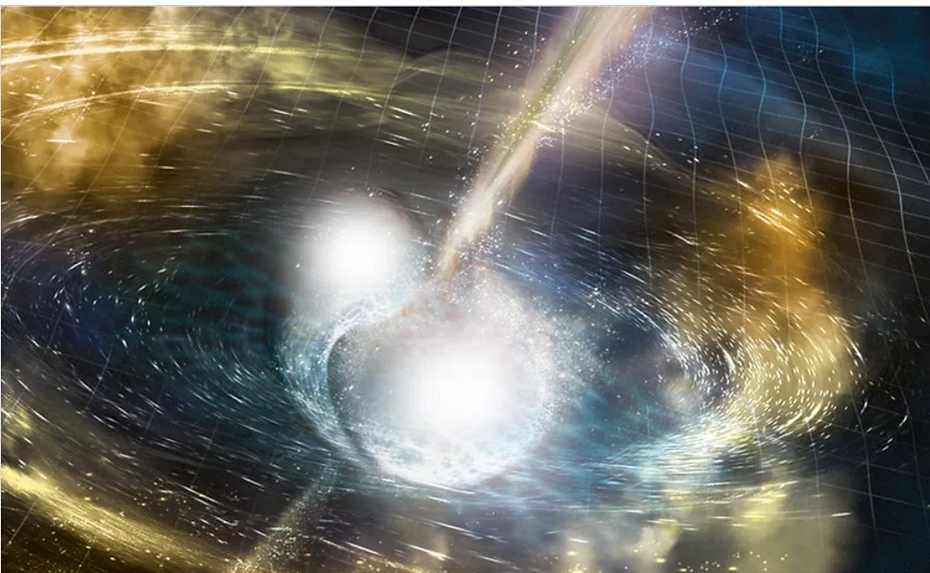1st-observed neutron star collision leads to breakthroughs by UC Berkeley University Astronomers

The observation of the explosive merger of two neutron stars has confirmed UC Berkeley researchers’ theories on the origin of precious metals, such as platinum, as well as previous theories regarding gravitational waves.
The collision, which was later identified as a neutron star merger, was observed Aug. 17 by the Laser Interferometer Gravitational-Wave Observatory, or LIGO, in the United States and by the Virgo detector in Italy. This is the first time researchers have successfully detected the gravitational waves that result from a neutron star merger.
“Following the collision of the stars, neutron-rich matter (neutron star ‘guts’) were ejected from the merger site at velocities up to 30 percent the speed of light,” said Brian D. Metzger, a physics professor at Columbia University, in an email. “This hot debris synthesized heavy elements, such as gold, platinum and silver within seconds as it expanded into space.”Previously, physicists from UC Berkeley and Lawrence Berkeley National Laboratory had developed theories about the origins of such metals. In models developed by Daniel Kasen, a UC Berkeley associate professor of physics and astronomy, UC Berkeley astronomy and physics professor Eliot Quataert, former UC Berkeley graduate student and postdoctoral fellow at Columbia University Jennifer Barnes and Metzger, the researchers described the radioactivity and brightness of an explosion that could result from a potential neutron star merger. They named this explosion a “kilonova” because of its high brightness.
To legitimize their theory, a collision between neutron stars would have to be observed first, which no one had been able to do until now.
“We have many satellites for detecting X-rays and gamma rays looking for these sorts of events, and we have ground-based telescopes waiting to do observations when the satellites see something interesting,” said John Tomsick, senior fellow at UC Berkeley’s Space Sciences Laboratory, in an email. “The part that was lucky was that one of these events happened so close (only 130 million light years away) … most people thought that we might be years away from detecting gravitational waves from a neutron star merger.”
The observation of both gravitational waves and light coming from the same event changes the way that scientists look at gravity. According to Quataert, this marks the first time ever that a cosmic event has been seen through both gravitational and light waves.
A neutron star is one of the closest entities to a black hole because of its immense mass. Being able to observe both the light and gravitational waves from neutron star collisions helps scientists better understand gravity aside from their observations of black hole collisions, which were previously the collisions from which LIGO had detected gravitational waves.
“This discovery opens up an entirely new way to go about our science,” Metzger said in an email.
The collision, which was later identified as a neutron star merger, was observed Aug. 17 by the Laser Interferometer Gravitational-Wave Observatory, or LIGO, in the United States and by the Virgo detector in Italy. This is the first time researchers have successfully detected the gravitational waves that result from a neutron star merger.
“Following the collision of the stars, neutron-rich matter (neutron star ‘guts’) were ejected from the merger site at velocities up to 30 percent the speed of light,” said Brian D. Metzger, a physics professor at Columbia University, in an email. “This hot debris synthesized heavy elements, such as gold, platinum and silver within seconds as it expanded into space.”Previously, physicists from UC Berkeley and Lawrence Berkeley National Laboratory had developed theories about the origins of such metals. In models developed by Daniel Kasen, a UC Berkeley associate professor of physics and astronomy, UC Berkeley astronomy and physics professor Eliot Quataert, former UC Berkeley graduate student and postdoctoral fellow at Columbia University Jennifer Barnes and Metzger, the researchers described the radioactivity and brightness of an explosion that could result from a potential neutron star merger. They named this explosion a “kilonova” because of its high brightness.
To legitimize their theory, a collision between neutron stars would have to be observed first, which no one had been able to do until now.
“We have many satellites for detecting X-rays and gamma rays looking for these sorts of events, and we have ground-based telescopes waiting to do observations when the satellites see something interesting,” said John Tomsick, senior fellow at UC Berkeley’s Space Sciences Laboratory, in an email. “The part that was lucky was that one of these events happened so close (only 130 million light years away) … most people thought that we might be years away from detecting gravitational waves from a neutron star merger.”
The observation of both gravitational waves and light coming from the same event changes the way that scientists look at gravity. According to Quataert, this marks the first time ever that a cosmic event has been seen through both gravitational and light waves.
A neutron star is one of the closest entities to a black hole because of its immense mass. Being able to observe both the light and gravitational waves from neutron star collisions helps scientists better understand gravity aside from their observations of black hole collisions, which were previously the collisions from which LIGO had detected gravitational waves.
“This discovery opens up an entirely new way to go about our science,” Metzger said in an email.
Thank you for your attention...
Stay in touch with us for more updates...
By :- My Science World

Comments
Post a Comment